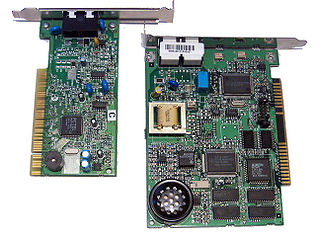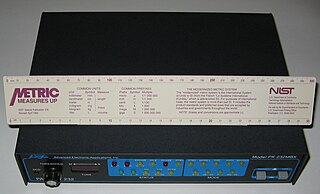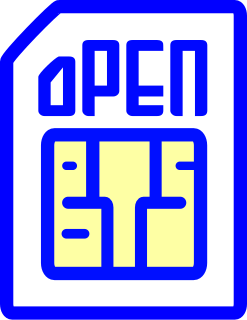Related Research Articles

In computer architecture, a bus is a communication system that transfers data between components inside a computer, or between computers. This expression covers all related hardware components and software, including communication protocols.

A workstation is a special computer designed for technical or scientific applications. Intended primarily to be used by one person at a time, they are commonly connected to a local area network and run multi-user operating systems. The term workstation has also been used loosely to refer to everything from a mainframe computer terminal to a PC connected to a network, but the most common form refers to the class of hardware offered by several current and defunct companies such as Sun Microsystems, Silicon Graphics, Apollo Computer, DEC, HP, NeXT and IBM which opened the door for the 3D graphics animation revolution of the late 1990s.
Systems Network Architecture (SNA) is IBM's proprietary networking architecture, created in 1974. It is a complete protocol stack for interconnecting computers and their resources. SNA describes formats and protocols and is, in itself, not a piece of software. The implementation of SNA takes the form of various communications packages, most notably Virtual Telecommunications Access Method (VTAM), the mainframe software package for SNA communications.

Software-defined radio (SDR) is a radio communication system where components that have been traditionally implemented in hardware are instead implemented by means of software on a personal computer or embedded system. While the concept of SDR is not new, the rapidly evolving capabilities of digital electronics render practical many processes which were once only theoretically possible.

A softmodem is a modem with minimal hardware that uses software running on the host computer, and the computer's resources, in place of the hardware in a conventional modem.

A terminal node controller (TNC) is a device used by amateur radio operators to participate in AX.25 packet radio networks. It is similar in function to the Packet Assembler/Disassemblers used on X.25 networks, with the addition of a modem to convert baseband digital signals to audio tones.
Networking hardware, also known as network equipment or computer networking devices, are electronic devices which are required for communication and interaction between devices on a computer network. Specifically, they mediate data transmission in a computer network. Units which are the last receiver or generate data are called hosts, end systems or data terminal equipment.
In computing, the term data warehouse appliance (DWA) was coined by Foster Hinshaw for a computer architecture for data warehouses (DW) specifically marketed for big data analysis and discovery that is simple to use and high performance for the workload. A DWA includes an integrated set of servers, storage, operating systems, and databases.

In routing, the forwarding plane, sometimes called the data plane or user plane, defines the part of the router architecture that decides what to do with packets arriving on an inbound interface. Most commonly, it refers to a table in which the router looks up the destination address of the incoming packet and retrieves the information necessary to determine the path from the receiving element, through the internal forwarding fabric of the router, and to the proper outgoing interface(s).

OpenBTS is a software-based GSM access point, allowing standard GSM-compatible mobile phones to be used as SIP endpoints in Voice over IP (VoIP) networks. OpenBTS is open-source software developed and maintained by Range Networks. The public release of OpenBTS is notable for being the first free-software implementation of the lower three layers of the industry-standard GSM protocol stack. It is written in C++ and released as free software under the terms of version 3 of the GNU Affero General Public License.
OpenFlow is a communications protocol that gives access to the forwarding plane of a network switch or router over the network.
Altair Semiconductor is a developer of high performance single-mode Long Term Evolution (LTE) chipsets. The company's product portfolio includes baseband processors, RF transceivers and a range of reference hardware products. Founded in 2005, Altair employs 190 employees in its Hod Hasharon, Israel headquarters and R&D center, and has regional offices in the United States, Japan, China, India, Finland, and France. Altair Semiconductor was the first chipset vendor to receive certification from Verizon Wireless to run on its 4G LTE network. Altair has also powered several devices launched on Verizon's network including the Ellipsis 7 tablet and HP Chromebook 11.6"LTE. In January 2016 it was announced that Sony was acquiring Altair for $212 Million.
In digital communications networks, packet processing refers to the wide variety of algorithms that are applied to a packet of data or information as it moves through the various network elements of a communications network. With the increased performance of network interfaces, there is a corresponding need for faster packet processing.
Software-defined networking (SDN) technology is an approach to network management that enables dynamic, programmatically efficient network configuration in order to improve network performance and monitoring, making it more like cloud computing than traditional network management. SDN is meant to address the fact that the static architecture of traditional networks is decentralized and complex while current networks require more flexibility and easy troubleshooting. SDN attempts to centralize network intelligence in one network component by disassociating the forwarding process of network packets from the routing process. The control plane consists of one or more controllers, which are considered the brain of the SDN network where the whole intelligence is incorporated. However, the intelligent centralization has its own drawbacks when it comes to security, scalability and elasticity and this is the main issue of SDN.
Network functions virtualization is a network architecture concept that uses the technologies of IT virtualization to virtualize entire classes of network node functions into building blocks that may connect, or chain together, to create communication services.

Open vSwitch, sometimes abbreviated as OVS, is an open-source implementation of a distributed virtual multilayer switch. The main purpose of Open vSwitch is to provide a switching stack for hardware virtualization environments, while supporting multiple protocols and standards used in computer networks.
Pica8, Inc. is a computer networking company headquartered in Palo Alto, California, United States. Pica8 is a vendor of open-standards-based operating systems on white box network switches delivering software-defined networking (SDN) solutions for datacenter and cloud computing environments and traditional L2/L3 solutions for large enterprise customers. The company's products include a Linux-based L2/L3 and OpenFlow-supporting network operating system, PICOS, which is shipped as standalone software that can be loaded onto a range of 1/10/40/100 Gigabit Ethernet switches based on commoditized switches purchased from original design manufacturers (ODMs).
SD-WAN is an acronym for software-defined networking (SDN) in a wide area network (WAN). SD-WAN simplifies the management and operation of a WAN by decoupling the networking hardware from its control mechanism. This concept is similar to how software-defined networking implements virtualization technology to improve data center management and operation.
Osmocom is an open-source software project that implements multiple mobile communication standards, including GSM, DECT, TETRA and others.
References
- ↑ http://www.limemicro.com Lime Microsystems
- ↑ http://secure.marketwatch.com/story/lime-microsystems-bladerf-legba-partner-on-first-software-defined-mobile-network-2014-04-30 Lime Microsystems: bladeRF, Legba partner on first software defined mobile network
- ↑ https://sites.google.com/site/callforchapterssdmn/ Call for Chapters (WILEY Publishers) Software Defined Mobile Networks (SDMN): Beyond LTE Network Architecture
- ↑ Abolhasan, Mehran; Lipman, Justin; Ni, Wei; Hagelstein, Brett (2015). "Software-defined wireless networking: Centralized, distributed, or hybrid?". IEEE Network. 29 (4): 32–38. doi:10.1109/MNET.2015.7166188.